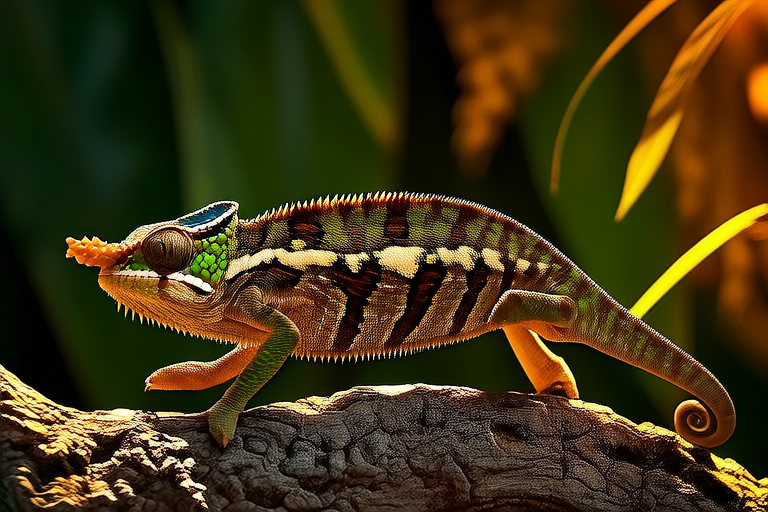Chameleon Care Guide: Expert Tips for Happy and Healthy Pets
Welcome to our comprehensive Chameleon Care Guide! Whether you’re a first-time chameleon owner or an experienced enthusiast, this guide will provide you with all the information you need to ensure your pet leads a happy and healthy life. We’ll cover everything from habitat setup to diet, health care, behavior, and common mistakes to avoid. Let’s dive right in!
Habitat Setup
The first step in creating a perfect environment for your chameleon is setting up their habitat. A well-designed enclosure ensures that your chameleon can thrive physically and mentally.
Enclosure Size
A good rule of thumb is to have at least 20 gallons of space per inch of the chameleon’s length. For example, a baby chameleon might require a 20-gallon tank, while an adult could need a 50-gallon or larger enclosure.
Lighting
Proper lighting is crucial for your chameleon’s health. They require UVB light for vitamin D synthesis and heat lamps to regulate their body temperature. Experts recommend using a high-quality UVB bulb that provides 10% to 12% UVB output. Place the bulb approximately 12 inches above the basking area. Ensure that the UVB light is replaced every six months to maintain its effectiveness.
Substrate
Avoid using substrate like sand or gravel as it can cause impaction if ingested. Instead, opt for paper towels, reptile carpet, or eco-friendly substrates designed specifically for chameleons.
Branches and Plants
Chameleons love climbing, so provide plenty of branches and live plants for them to explore. Ficus benjamina (weeping fig) and pothos are popular choices due to their durability and ease of care. Arrange these items at different heights to encourage climbing and exercise.
Maintenance Routines
- Weekly: Clean any visible waste and mist the plants.
- Monthly: Thoroughly clean the entire enclosure, replacing substrate and disinfecting all surfaces.
Diet
Feeding your chameleon the right diet is essential for their growth and overall health. Chameleons are insectivores, which means they primarily eat insects.
Insects
Offer a variety of insects such as crickets, dubia roaches, and silkworms. Gut-load these insects with nutritious foods before feeding them to your chameleon to maximize nutritional value.
Vitamin and Mineral Supplementation
Supplement your chameleon’s diet with calcium and vitamins. Dust insects with calcium powder twice weekly and a multivitamin once a week. Be cautious not to over-supplement, as excessive amounts can be harmful.
Feeding Schedule
Feed juveniles daily, reducing frequency to every other day as they mature. Always remove uneaten insects after one hour to prevent potential harm.
Maintenance Routines
- Daily: Check for uneaten food and refill water dishes.
- Weekly: Monitor weight and adjust feeding quantities accordingly.
Health Care
Regular health checks and preventive measures can help keep your chameleon in top condition. Early detection of issues is key to successful treatment.
Signs of Illness
Monitor your chameleon for signs of illness, including lethargy, loss of appetite, runny nose, or swollen eyes. If you notice any concerning symptoms, consult a veterinarian specializing in reptiles immediately.
Parasite Prevention
Have your chameleon tested for parasites during routine veterinary visits. Follow your vet’s recommendations for prevention and treatment.
Vaccinations and Annual Check-Ups
While chameleons don’t require vaccinations, annual check-ups are recommended to monitor overall health and catch potential issues early.
Maintenance Routines
- Monthly: Perform a fecal examination for parasites.
- Annually: Schedule a comprehensive veterinary examination.
Behavior
Understanding your chameleon’s behavior helps build a strong bond and ensures their well-being.
Interacting with Your Chameleon
Handle your chameleon gently and infrequently to minimize stress. Use a soft net or hand to gently guide them into a secure container when necessary.
Social Behavior
Chameleons are solitary animals by nature. While they may coexist peacefully in the wild, keeping multiple chameleons together in captivity can lead to aggression and stress. It’s best to house each chameleon individually.
Environmental Enrichment
Provide mental stimulation through varied habitats, interactive toys, and regular handling sessions. Rotate plant species and rearrange branches periodically to keep your chameleon engaged.
Maintenance Routines
- Daily: Observe behavior for changes.
- Weekly: Introduce new toys or rearrange habitat.
Common Mistakes to Avoid
Even experienced chameleon owners can make mistakes. Here are some common pitfalls to watch out for:
- Improper Lighting: Insufficient UVB exposure can lead to metabolic bone disease.
- Incorrect Feeding: Over-supplementation or feeding inappropriate insects can cause health problems.
- Lack of Hydration: Dehydration is a significant concern. Ensure fresh water is available daily.
- Stressful Handling: Frequent or rough handling can increase stress levels.
Frequently Asked Questions
- How often should I mist my chameleon?
- Mist your chameleon’s enclosure two to three times daily, ensuring the plants are thoroughly moistened.
- Can I use tap water for my chameleon?
- No, use filtered or distilled water to avoid contaminants harmful to your chameleon.
- What is the best way to handle my chameleon?
- Use a soft net or hand to gently guide them into a secure container, minimizing direct contact.
Conclusion
By following the expert tips provided in this Chameleon Care Guide, you’ll be well-equipped to provide your chameleon with a happy and healthy home. Remember to stay informed about the latest care practices and always consult with a veterinarian if you have concerns about your chameleon’s health. With proper care and attention, your chameleon can enjoy a long and fulfilling life as your beloved pet.
